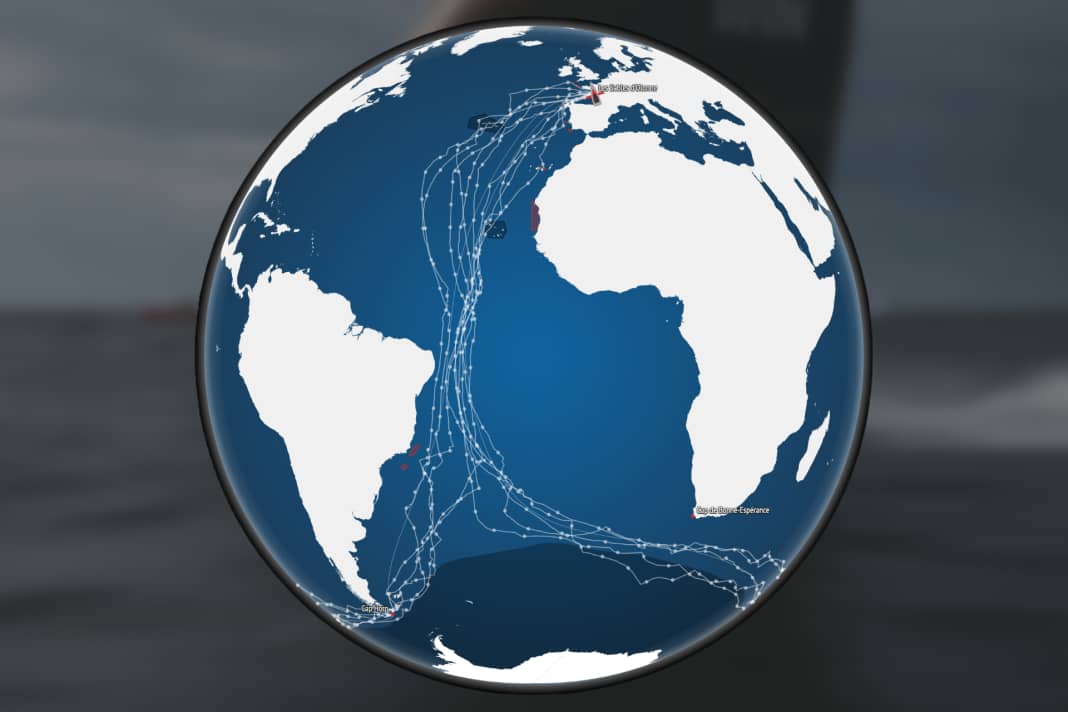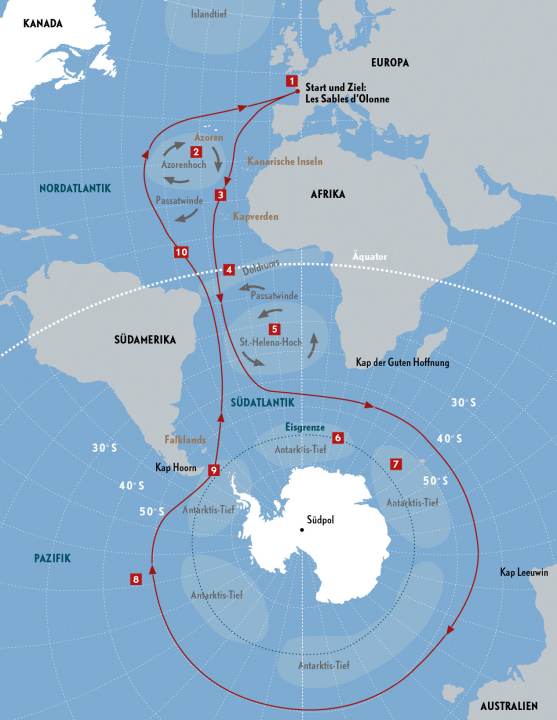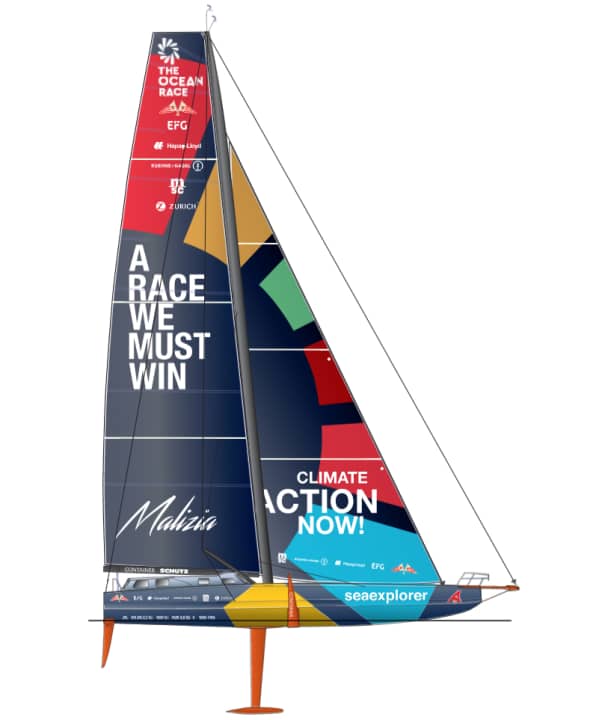Vendée Globe: No record again? - the hotspots on the route around the world






The skippers cover around 28,000 nautical miles in the Vendée Globe. Frenchman Armel Le Cléac'h took 74 days, 3 hours, 35 minutes to complete the penultimate edition in 2016/17 for this distance and thus holds the record for the daring circumnavigation. In a thrilling duel, he prevailed against the Brit Alex Thomson and beat François Gabart's existing record (2012/13) by almost four days.
After Boris Herrmann's Vendée premiere in 2020/21 failed to circumnavigate the globe in a new record time, a certain hope and confidence had been built up in the run-up to the upcoming tenth edition. In view of the enormous performance development in the Imoca class this is also quite realistic, but ultimately other factors will also be decisive.
According to initial calculations, the meteorologists before the start The weather situation at the start of the race is difficult. This could already cost important days and hours for a record journey, and some skippers also expressed their concerns. The fastest boats are expected to take around ten days to reach the equator, whereas eight years ago the best boats only took a good six days. However, the weather and other as yet undetermined uncertainties, such as the exact location of the ice edge, will continue to determine the speed of the fleet as the route progresses. Further down in the article we explain the most important hotspots on the route around the world.
The three main stages of the Vendée Globe
However, the Vendée Globe can basically be divided into three main stages: the first third in the Atlantic, the Southern Ocean and the final third back in the Atlantic. The sailors not only have to cope with a wide variety of wind and wave conditions, but also cross different climate zones with autumn weather at the start, heat at the equator and sub-polar cold in the south.
In addition to setting up the yacht correctly in order to sail at maximum speed, weather routing is one of the most important tasks on board. Using weather forecasts and appropriate software, such as the Adrena routing programme, skippers try to find the best course past calm areas and around severe storms. They rely solely on their own knowledge; outside help, such as from external weather experts, is prohibited. Although the programmes, fed with appropriate forecast data, can look several days and sometimes weeks ahead, these are always only calculations of probabilities. In the end, it is up to the knowledge and experience of each skipper to follow the suggestions of the software or to rely on their own intuition.
Location of the ice edge also of great importance for the 10th Vendée Globe
In the first phase of the race, the participants usually go full throttle, and by the time they reach the Southern Ocean, the wheat has usually been separated from the chaff. This is because whoever reaches one of the high-wind, low-pressure areas travelling from west to east first is almost impossible to catch up with - like a ski lift where you catch the first gondola. With more advanced foils and higher speeds, the boats can sail along with these low-pressure areas for longer than before, meaning that the phases with less wind in between, in which the field can push together, are decreasing.
However, the virtual ice boundary brings the participants closer to northern high-pressure areas than before, which could result in interesting constellations. The exact coordinates of the zone around Antarctica will also be adjusted during the race depending on the ice conditions for the safety of the participants and could therefore become a decisive parameter for the duration of the circumnavigation. The closer you are allowed to sail around the South Pole, the shorter the distance will be. The AEZ (Antarctic Exclusion Zone) is also included in the Live tracker to see. The same applies to the two nature conservation zones (around the Azores and Cape Verde) and the various traffic separation schemes.
The final stage then begins when they reach Cape Horn. Here, the front runners try to secure their position towards the back. Due to the changing conditions, exciting boat-to-boat battles can develop.
The most important hotspots on the route:

1. the Bay of Biscay
If the Azores high extends far to the east at the start time, moderate conditions can be expected. The situation is different if one of the areas of low pressure moves from Newfoundland to Europe. Then it could be a very tough first day with lots of wind and sometimes chaotic waves
2nd Azores High
The mostly light wind zone should be avoided, so don't sail too far to the west
3. Canary Islands/Cape Verde
The island groups offer a wide range of tactical possibilities. Accelerating jet effects can form between the islands, but cover and lull zones also lurk downwind of them
4th Doldrums
In this area, also known as the intra-tropical convergence zone or calms, the two trade winds, the north-east and south-east trade winds, collide. This area is characterised by thunderstorms, sudden strong gusts and lulls as well as sometimes very high waves
5th St Helena High
The pronounced light wind zone blocks the direct route to the south and is circumnavigated to the west. The skippers try to catch the smaller areas of low pressure moving eastwards from the Brazilian coast. However, they want to stay as far away from the coast as possible, as otherwise they would sail too far. This means that only a narrow band is available for course selection
6. ice boundary
To prevent collisions with icebergs and growlers, the race organisers have set up a protection zone, the Antarctic Exclusion Zone (AEZ). It is an imaginary circle around the Antarctic between 45 degrees south at the Crozet Islands and 68 degrees south at Cape Horn, between these marks there are further GPS points, which together form a line. This line may not be crossed. The zone will be adjusted during the race depending on the ice conditions.
7 Southern Ocean
The circumnavigation of Antarctica accounts for almost a third of the total distance and is considered the toughest part. It is characterised by cold, strong winds and high waves. After leaving the South Atlantic, the aim is to catch one of the low-pressure areas coming from Brazil, Madagascar or New Zealand as quickly as possible on the way eastwards. These move in a west-easterly direction, so the Antarctic circumnavigation usually takes place in rough winds
8. lulls
The ice limit forces skippers to take a more northerly route than before, and there is a risk of getting caught in one of the high pressure areas of the Indian Ocean or Pacific Ocean
9th Cape Horn
Its southward extension brings the yachts under the 56th parallel south and thus into the "furious fifties", which are notorious for their stormy winds
10. way back
In the last third, the same navigational and weather tactical challenges as in the first part have to be mastered: the St Helena High, the Doldrums, the Azores High and the Bay of Biscay
"Malizia - Seaexplorer" - a record breaker?
If the weather conditions and the ice limit allow a record journey, there are undoubtedly enough ships in the field that have what it takes to set a new best time around the world. In addition to the Relevant top favourites including the heavily modified current record holder, Le Cléac'h's "Banque Populaire VIII", under her new name "Medallia", with British skipper Pip Hare.
Boris Herrmann and his "Malizia - Seaexplorer" have what it takes to break records, as the German offshore professional has already proven in the Ocean Race. With his crew he set a new absolute record of 641.13 nautical miles in 24 hours. It is possible that, if not the course record, at least the 24-hour solo record will be broken at the Vendée. The boats of the last Imoca generation have never been more sophisticated and faster, which is mainly thanks to the development of the foil. The wing mast and tilt keel, on the other hand, are the same for all boats.

Technical data
- Designer / Shipyard: VPLP / Multiplast
- Torso length: 18,28 m
- Total length: 20,12 m
- Width: approx. 5.60 m
- Depth: 4,50 m
- Mast height above WL: 29,00 m
- Weight: approx. 8.8 tonnes
- Ballast/proportion: approx. 2.3 tonnes / 26 %
- Sail area downwind / STZ: approx. 265 m² / 7.9
- Motor (Lombardini LDW 1003): 30 HP

